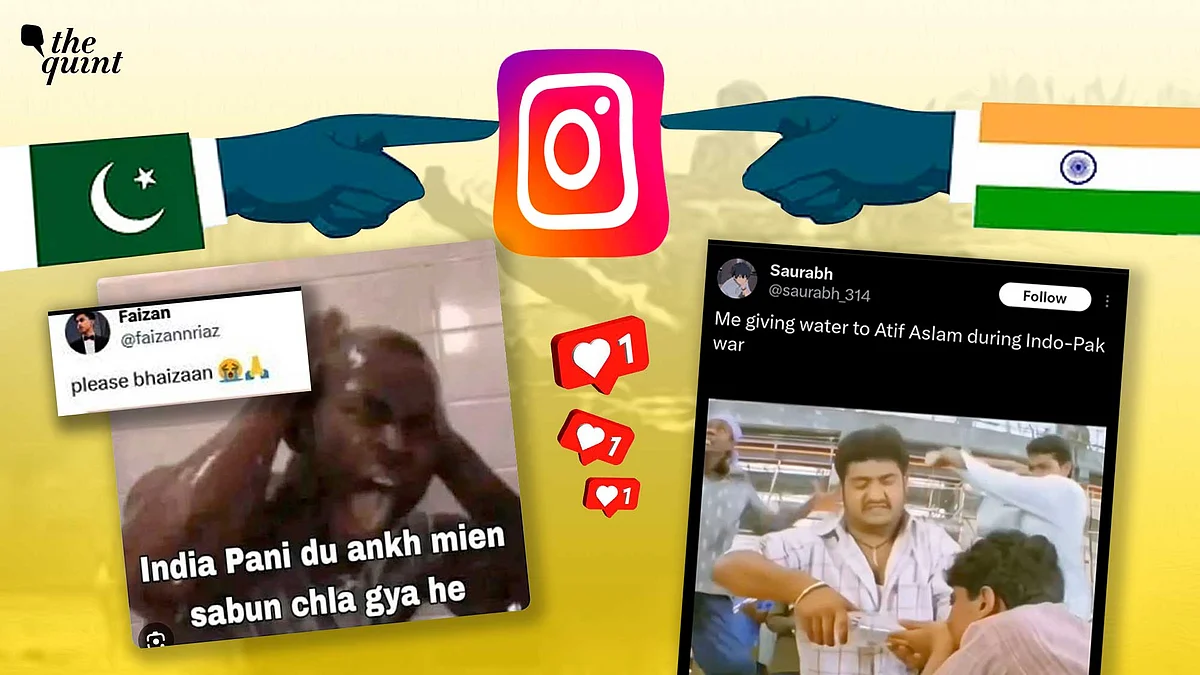Pakistan’s War Fears, Told One Meme at a Time
Instagram reels don't follow territorial logic, even between people from so-called 'enemy' nations.

advertisement
“Please restart the Indus motor for a bit, I need to do skincare,” says one Pakistani meme on Instagram. “Let me talk to Modiji; no messing up with skincare,” replies an Indian user in the comments.
In the past two-three days, I have come across innumerable such reels and memes from Pakistani Instagram users. Some content creators can be seen doing a 'fit check' in anticipation of the war, some crack jokes about running out of water as the Indian government suspends the Indus Waters Treaty, and some teenage users can be seen asking whether they should stop preparing for school exams.
“I thought let me try an avocado before the war [begins], because you never know…,” says another young man from Pakistan in a reel.
“I paid a thousand rupees for it, a thousand!” he continues as he starts cutting the avocado in front of the camera. As funny as his gallows humour is, what I found more fascinating is the number of comments from Indian users in response to his reel.
“As I was scrolling through, I reached the other side of the border,” commented one user.
“Right now we have some issues between us, otherwise I would have recommended a great recipe,” commented another.
Even as geopolitical tensions between India and Pakistan simmer after the heinous terrorist attack in Pahalgam that killed at least 26 Indians, a section of Indian and Pakistani social media users have found a way to reach out to each other in the most ingenious way.
Instagram reels do not follow territorial logic. In theory, an Indian user can encounter reels from any part of the world. Once they started encountering Pakistani reels and interacting with them, they started seeing more and more of them. The Instagram algorithm tracks your content consumption pattern and shows content that will presumably keep you hooked.
Dark Humour, Darker Realities
The Indian State sees Pakistan as an enemy state and vice versa. In this geopolitical logic, even ordinary citizens of the “enemy country” become suspect in the eyes of the State. In one of its first retaliatory actions after the terrorist attack, the Indian government revoked visas of Pakistani nationals holding short-term visas.
It would be foolhardy to make any broad claims merely based on the evidence that people from the two countries have been laughing at the same memes. But it shows that humour can transcend borders and engender affective energy, even between people belonging to the so-called enemy countries.
In the guise of “war memes,” the Pakistani content creators touched upon many topics that were easily recognisable and relatable across the border, such as aspirational lifestyle (think about the avocado eater), water issues, anxiety around school exams, obsession with marriage, and the senseless jingoism of the elite.
Pakistani creators were creating memes for their own country-people but they accidentally found a captive audience across the border too.
Memetics, Affect and War Angst
Interestingly, this has a precedent. After the 1965 Indo-Pakistan war, All India Radio (AIR) started an Urdu-language programme aimed at West Pakistan in an effort to counter Pakistani propaganda, but AIR soon realised that many people were tuning in from India itself. In her book Radio for Millions, scholar Isabel Huacuja Alonso notes how this service soon became a forum for Indian and Pakistani listeners to reach out to each other.
The AIR radio programme encouraged listeners to send in letters, which were read out on air. Alonso writes that these letters “enabled listeners across the Indo-Pakistan divide to remain in conversation with each other. For AIR Urdu Service’s audiences, the letters were a place of physical contact across the western Indo-Pakistan border, which by that time, for most, had become all but impassible.”
Alonso mentions a particularly evocative example.
Along with the human need for connection, we see the role of technology in engendering such loose, temporary affective publics. As opposed to radio, the social media users can directly reach out to each other without radio broadcasters acting as gatekeepers.
Additionally, the scale of content and comments generated on social media is much higher than the letters written to AIR in the 1970s. The affordances of social media platforms, such as their transnational character, the vibrant comments section, the shareability of content, and content creators coalescing around trends to get more views, made it possible for people to form a cross-border affective public around a topic as grim as war.
What is an affect? Scholar Zizi Papacharissi writes,
“Affect is not emotion. It is the intensity with which we experience emotion. It is the slight tap on our foot when we hear a song but have not yet cognitively processed that we like it. It is the phatic nod we produce when we are listening along to what someone is saying, but we have not yet decided whether we fully agree or not. More precisely, it is the drive or sense of movement experienced before we have cognitively identified a reaction and labeled it as a particular emotion.”
As immense sadness pervades in India at the Pahalgam killings, and as Pakistanis wake up every day wondering whether the war will break out, the memes allow them to process these excess emotions.
They may not know what exactly they are feeling but they are feeling something — and that’s affect.
(Tejas Harad is a PhD scholar at Annenberg School for Communication, University of Pennsylvania. The views expressed above are the author’s own. The Quint neither endorses nor is responsible for them.)